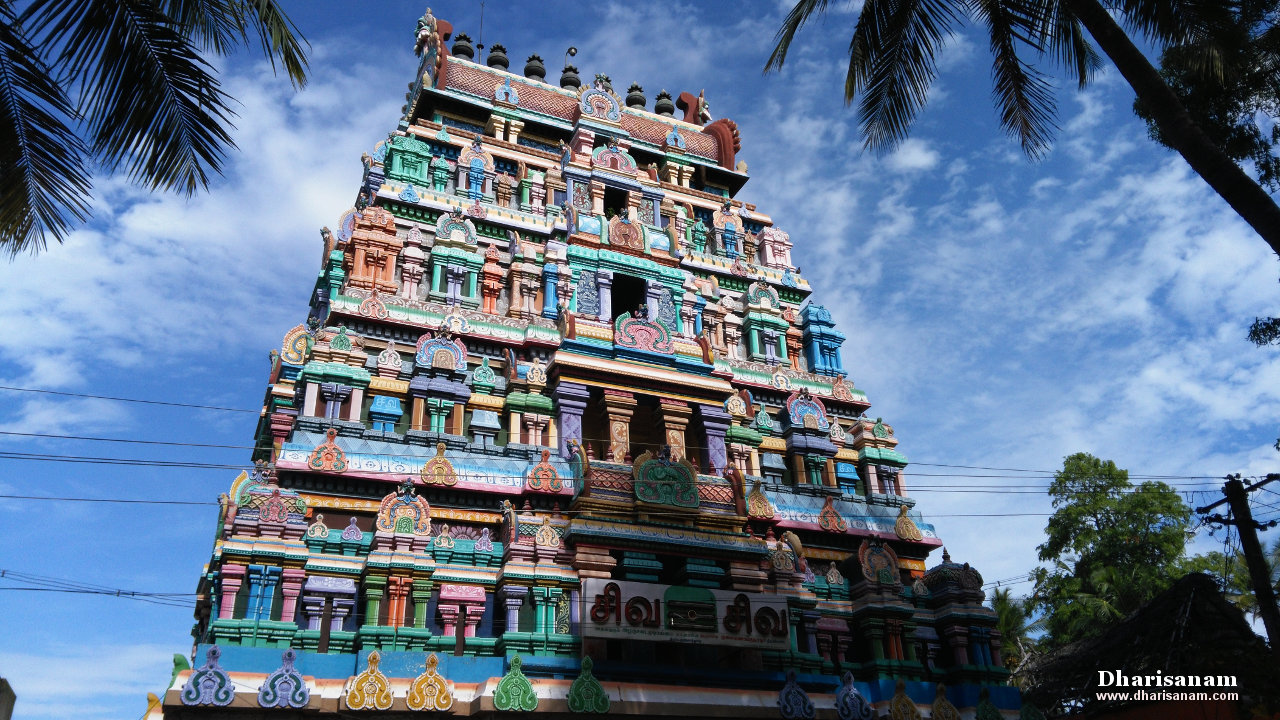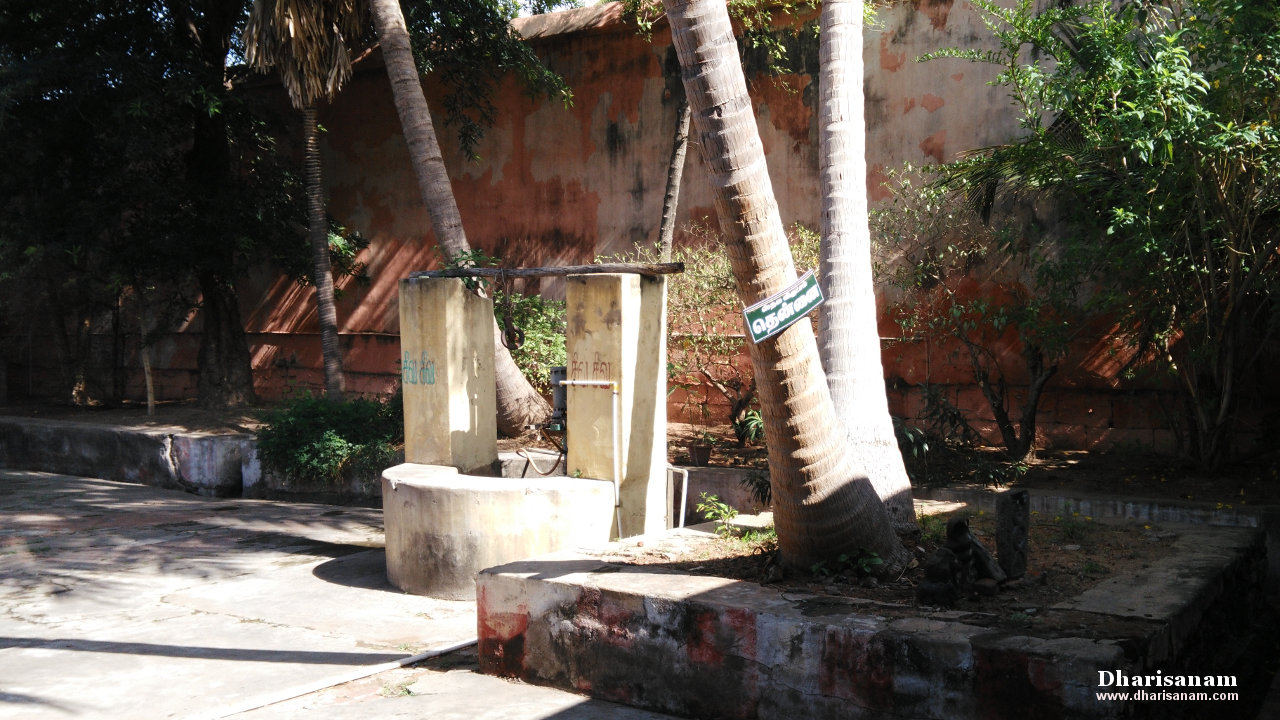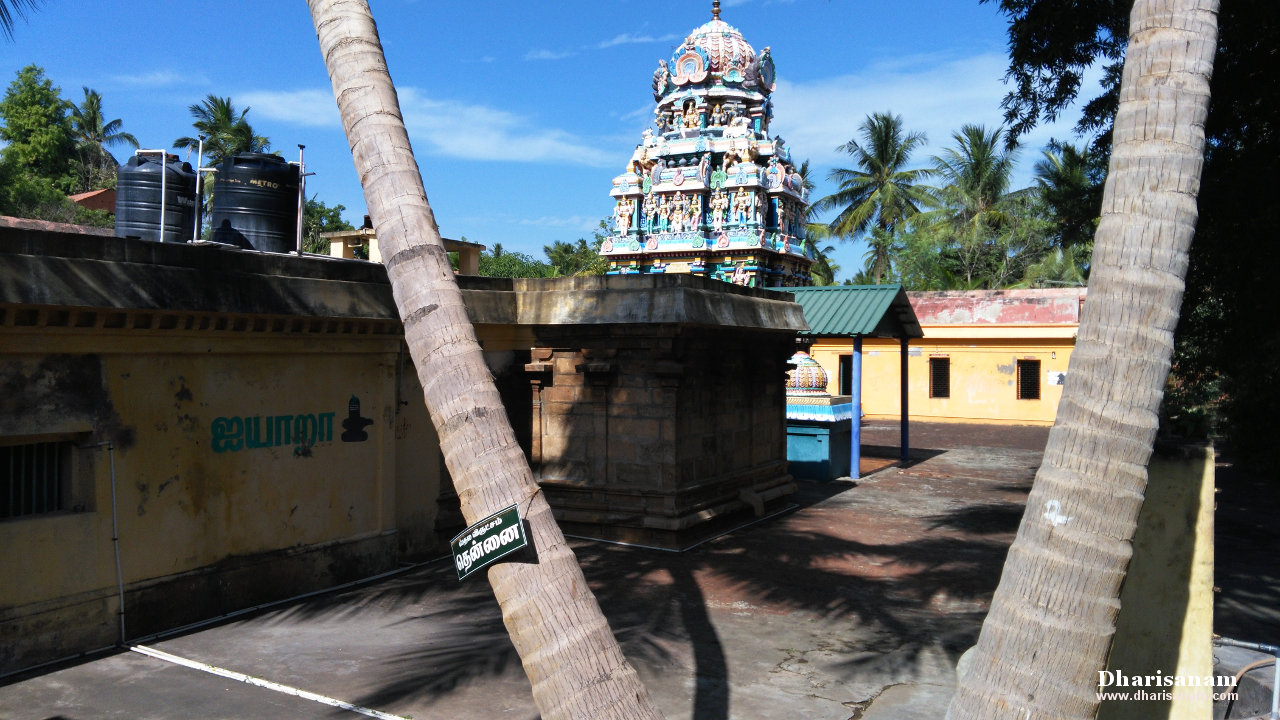Visited on: 30th June, 2018.
Location
Vada Kurangaduthurai is situated at a distance of about 22 kms from Kumbakonam on the Kumbakonam to Thiruvaiyaru route. It is less than a kilometre from Aduthurai Perumal Koil en route Ganapathy Agraharam. From Thiruvaiyaru, this place is about 11 kms away.
Other Devara Paadal Petra Shiva Sthalam near this place are –
Thiruppazhanam, Thiruvaiyaru, Thiru Neithanam, Perumpuliyur, Thiru Mazhapadi, Thirukkandiyur, Thiru Chotruthurai, Thiruvedhikudi, Thiruvirkudi, Thiru Nallur and Thiru Palaithurai.
General Information
| Moolavar | Sri Dhayanidheeswarar, Sri Vaalinathar, Sri Kulai Vanangu Nathar, Sri Chitti Lingeswarar, Sri Azhagu Sadai Mudi Nathar |
| Ambal | Sri Azhagu Sadai Mudi Ammai, Sri Jadamagudeswari |
| Theertham (Holy water) | Cauvery river |
| Sthala Vriksham (Sacred Tree) | Coconut tree |
| Pathigam (Hymn) rendered by | Saint Thirugnanasambanthar-1 |
- This is one of the 276 Devara Paadal Petra Shiva Sthalams and 49th Shiva Sthalam on the Northern bank of the river Cauvery in Chozha Nadu (Vadakarai).
- Lord Shiva in this temple is a Swayambumurthi (self-manifested).
- This east facing temple has two corridors and its main tower (Rajagopuram) has 5-tiers.
- This temple has no flag post (Dwajasthambam).
History of the Temple
This ancient temple is believed to have been built about 1300 years ago.
There are some stone inscriptions here which date back to the periods of Chola Kings - Koppara Kesari Varman, Pandian Thalaikonda Koppara Kesari Varman, Raja Rajan-I, Rajendran-I, Kulothungan-III and Pandiya King Vikrama Pandiya Devan.
There are two places by the name of “Kurangaduthurai”. At these two places, Lord Shiva is believed to have been worshiped by two monkeys (“kurangu” in Tamil) from Ramayana – Sugreev and Vaali.
This place is called as “Vada Kurangaduthurai” as it is located on the northern side of the river Cauvery and Vaali is believed to have worshiped Lord Shiva here. The other Kurangaduthurai is called “Then Kurangaduthurai” since it is located on the southern side of the river Cauvery and Sukreevan is believed to have worshiped the Lord Shiva there.
This place (Vada Kurangaduthurai) is now also known as Aaduthurai Perumal Koil.
This temple is one of the 88 temples controlled by Tanjore Palace Devasthanam and it is also under the purview of the Hindu Religious and Charitable Endowments Department of Government of Tamil Nadu (HR&CE).



Legend
As per legend, on a hot summer day, a pregnant woman and her husband were passing through this place. As she was plagued by extreme thirst and fatigue, her husband set out in search of some water for her. However, she fainted before her husband could return. As she had been praying to Lord Shiva asking for his help, the Lord came to her rescue. The Lord made a coconut tree bend and arranged some tender coconuts to quench the thirst of the woman. When her husband returned, she told him what had happened, but he did not believe her. At this point, Lord Shiva along with Goddess Parvathy gave their darshan to this couple. Hence, the lord here is praised as “Sri Kulai Vanangeesar” (“Kulai” means a bunch of coconuts in Tamil). The idol of this woman known as a “Chetti pen” can be seen in this temple’s hall. (“Chetti” refers to the “chettiyar” caste and “pen” means girl in Tamil).
Another legend is that Vaali’s tail got cut in the Ramayana war and it is believed that he visited this place and worshiped Lord Shiva. The lord blessed him, and his tail was restored. Hence the lord here is praised as “Sri Vaali Nathar”.
Another legend associated with this place is that a bird (Chittukuruvi) worshiped Lord Shiva here. The Lord was pleased by the worship and blessed the bird with salvation. Hence the lord here is also praised as “Sri Chittilingeswarar”.
As per the Sthalapuranam, Hanuman prayed to Lord Shiva at five different temples in order to seek absolution for “Shiva Aparatham” (a grave sin). This temple is one among them.
Deities in the temple
Other than the shrines of Lord Shiva and Goddess Parvathy, shrines and idols of
Sthala Vinayakar, Murugan with his consorts, Kayilaya Lingam with two more Shivalingams, Mahalakshmi, Navagraham, Chandikeswarar, Bairavar, Kala Bairavar, Suryan, Aadhi Amman, Nagar, Thirugnanasambanthar, Sundarar, Thirunavukkarasar and the “Chetti Pen” can be seen in the main hall and the corridors.
There is a separate shrine for Lord Saneeswarar known as “Pongu Saneeswarar”.
At the sanctum’s entrance, Idol of Vinayakar and Dwarabalakas “Thindi” and “Mundi” can be seen.
Idols of Dhwara Vinayakar, Arumugar and Poorna Pushkalaambal Iyyanar are also in the main hall.
In the “koshtam” (place surrounding the sanctum sanctorum), idols of Vinayakar, Narthana Ganapathy, Lingothbavar, Dakshinamurthy, Arthanareeswarar, Brahma and Vishnu Durgai can be seen.
Stone idols of Natarajar and Goddess Sivakami can be seen in the main hall.
There is a separate shrine in the outer corridor for “Maaya Karuppu” (a guardian deity).








Salient Features
Lord Natarajar is normally seen in the form of procession idol in most of Shiva temples. However, he is present here with Goddess Sivakami in stone sculpture. This shrine is named as “Aadhi Chidambaram”.
In this temple, the idols of Ardhanareeswarar, Brahma, Durgai and Natarajar look very beautiful.
The idol of goddess Vishnu Durgai with 8 hands is very special here. The uniqueness of this temple is that during abhishekam, the milk offered on this Durgai changes its colour to blue.
There is a beautiful idol here of Lord Dakshinamurthy and his 8 disciples with a banyan tree behind him.
There is a beautiful relief in a pillar in the main hall depicting Vaali worshiping Lord Shiva. In that relief few more monkeys can be seen assisting him.
There are sculptures in the sanctum tower showing Vaali worshiping the lord and the Chetti Pen receiving coconut from the lord.
In his hymn of this temple, in stanzas 6 and 8, Saint Thirugnanasambanthar mentioned about Vaali’s worship of Lord Shiva here.
At the top of the second entrance to this temple, there is a beautiful sculpture of Lord Shiva and Goddess Parvathy with Vinayakar on the lord’s lap and Murugan on the goddess’s lap. Nandhi is seen standing next to them and playing “Mirudangam” (a musical instrument). On either side of this sculpture there are paintings depicting the legends of this temple – Vali worshiping the lord and the woman getting the tender coconut.
Saint Arunagirinadhar has sung songs in praise of Lord Murugan of this temple in his revered Thirupugazh.




Greatness of this temple
Pregnant women pray to Goddess Parvathy here for safe childbirth.
It is believed that those seeking “Santhana Prapthi” (child boon) can pray to the lord here.
Devotees believe that by worshiping the lord here, obstacles from their marriage proposals will be removed.
Important Festivals
Some of the important festivals celebrated in this temple are –
Vinayakar Chaturthi in the Tamil month of Aavani (Aug-Sept),
Navarathri in the Tamil month of Purattasi (Sept-Oct),
Skanda Shashti and Annabishekam in the Tamil month of Aippasi (Oct–Nov),
Thiru Karthikai in the Tamil month of Karthikai (Nov-Dec),
Shivrathri in the Tamil month of Masi (Feb-Mar) and
Somavaram in the Tamil month of Karthikai (Nov-Dec).
Pradosham is also observed regularly.
Temple Timings
From 08:00 AM to 12:00 Noon and from 04:30 PM to 08:00 PM.
Temple Address
Sri Dhayanidheeswarar Swamy Temple,
Vada Kurangaduthurai,
(Aaduthurai Perumal Koil),
Ullikkadai Post,
Ganapathy Agraharam Via,
Papanasam Taluk,
Tanjure District,
Tamil Nadu – 614 202.
Tele: +91 – 04374 - 240491, 244191.
This temple’s care taker Mr.Balamurugan can be contacted at +91- 97877 42454.






Pathigam (Hymn) with English transliteration and Tamil meaning.
Saint Thirugnanasambanthar visited this temple and sang this Pathigam.
Devotees visiting this temple should make it a practice to recite this Pathigam.
Pathigam No.3.091.
கோங்கமே குரவமே கொழுமலர்ப் புன்னையே கொகுடிமுல்லை
வேங்கையே ஞாழலே விம்முபா திரிகளே விரவியெங்கும்
ஓங்குமா காவிரி வடகரை யடைகுரங் காடுதுறை
வீங்குநீர்ச் சடைமுடி அடிகளா ரிடமென விரும்பினாரே.
“Kōṅkamē kuravamē kozhumalarp puṉṉaiyē kokuṭimullai
vēṅkaiyē ñāzhalē vim'mupā thirikaḷē viraviyeṅkum
ōṅkumā kāviri vadakarai yaṭaikuraṅ kāduthuṟai
vīṅkunīrch chaṭaimuṭi aṭikaḷā riṭameṉa virumpiṉārē”.
கோங்கு, குரவம், செழித்த மலர்களைத் தரும் புன்னை, கொகுடி, முல்லை,
வேங்கை, புலிநகக் கொன்றை, பாதிரி ஆகிய மரங்களை அடித்துவரும்
காவிரியின் வடகரையிலுள்ள குரங்காடுதுறை என்னும் திருத்தலத்தைச்
சிவபெருமான் தமது இருப்பிடமாகக் கொண்டு விரும்பி வீற்றிருந்தருளுபவர்.
மந்தமா யிழிமதக் களிற்றிள மருப்பொடு பொருப்பின்நல்ல
சந்தமார் அகிலொடு சாதியின் பலங்களுந் தகையமோதி
உந்துமா காவிரி வடகரை யடைகுரங் காடுதுறை
எந்தையார் இணையடி இமையவர் தொழுதெழும் இயல்பினாரே.
“Manthamā yizhimathak kaḷitṟiḷa maruppoṭu poruppiṉnalla
santhamār akiloṭu sāthiyiṉ palaṅkaḷun thakaiyamōthi
unthumā kāviri vadakarai yaṭaikuraṅ kāduthuṟai
enthaiyār iṇaiyaṭi imaiyavar thozhuthezhum iyalpiṉārē”.
சிறு அளவில் மதம் சொரியும் யானைக் கன்றுகளின் தந்தங்களையும், நல்ல
சந்தனம், அகில், சாதிக்காய் ஆகிய பயன்தரக்கூடிய மரங்களையும்
விழும்படி மோதி, அலைகளால் அடித்துவரும் காவிரியின் வடகரையிலுள்ள
குரங்காடுதுறை என்னும் திருத்தலத்தில் வீற்றிருந்தருளும் எந்தையாகிய
சிவபெருமானின் திருவடிகளைத் தேவர்கள் தொழுது எழும் தன்மையர்.
முத்துமா மணியொடு முழைவளர் ஆரமும் முகந்துநுந்தி
எத்துமா காவிரி வடகரை யடைகுரங் காடுதுறை
மத்தமா மலரொடு மதிபொதி சடைமுடி யடிகள்தம்மேற்
சித்தமாம் அடியவர் சிவகதி பெறுவது திண்ணமன்றே.
“Muththumā maṇiyoṭu muzhaivaḷar āramum mukanthununthi
eththumā kāviri vadakarai yaṭaikuraṅ kāduthuṟai
maththamā malaroṭu mathipothi saṭaimuṭi yaṭikaḷtham'mēṟ
siththamām aṭiyavar sivakathi peṟuvathu thiṇṇamaṉtṟē”.
முத்து, மணி, குகைகளின் அருகில் வளரும் சந்தனமரம் இவற்றை வாரி,
தள்ளி மோதும் காவிரியின் வடகரையில் உள்ள குரங்காடுதுறை என்னும்
திருத்தலத்தில் வீற்றிருந்தருளும், பெருமை மிகுந்த பொன்னூமத்த மலரோடு, சந்திரனையும் அணிந்து உள்ள சடைமுடி உடைய தலைவரான
சிவபெருமானைச் சித்தத்தால் வழிபடும் அடியவர்கள் சிவகதி பெறுவது
உறுதி.
கறியுமா மிளகொடு கதலியின் பலங்களுங் கலந்துநுந்தி
எறியுமா காவிரி வடகரை யடைகுரங் காடுதுறை
மறியுலாங் கையினர் மலரடி தொழுதெழ மருவுமுள்ளக்
குறியினா ரவர்மிகக் கூடுவார் நீடுவா னுலகினூடே.
“Kaṟiyumā miḷakoṭu kathaliyiṉ palaṅkaḷuṅ kalanthununthi
eṟiyumā kāviri vadakarai yaṭaikuraṅ kāduthuṟai
maṟiyulāṅ kaiyiṉar malaraṭi thozhuthezha maruvumuḷḷak
kuṟiyiṉā ravarmikak kūṭuvār nīṭuvā ṉulakiṉūṭē”.
உறைக்கும் மிளகுச் செடிகளோடு, வாழையும் கலந்து தள்ளி வரும்
காவிரியின் வடகரையில் விளங்கும் குரங்காடுதுறை என்னும் திருத்தலத்தில் மான்கன்றை ஏந்திய கையையுடைய சிவபெருமானின் திருவடிகளைத் தொழுது, உள்ளம் உருகப் போற்றுபவர்கள் வானுலகடைந்து மேன்மையுடன் மகிழ்ந்திருப்பர்.
கோடிடைச் சொரிந்ததே னதனொடுங் கொண்டல்வாய் விண்டமுன்னீர்
காடுடைப் பீலியுங் கடறுடைப் பண்டமுங் கலந்துநுந்தி
ஓடுடைக் காவிரி வடகரை யடைகுரங் காடுதுறை
பீடுடைச் சடைமுடி யடிகளா ரிடமெனப் பேணினாரே.
“Kōṭiṭaich chorinthathē ṉathaṉoṭuṅ koṇṭalvāy viṇṭamuṉṉīr
kāṭuṭaip pīliyuṅ kaṭaṟuṭaip paṇṭamuṅ kalanthununthi
ōṭuṭaik kāviri vadakarai yaṭaikuraṅ kāduthuṟai
pīṭuṭaich chaṭaimuṭi yaṭikaḷā riṭameṉap pēṇiṉārē”.
மரக்கிளைகளில் சொரிந்த தேனோடு, மேகம் பெய்த முன்னீரும் கலக்கக்
காட்டில் வசிக்கும் மயிலின் பீலியும், மலைச்சாரலில் விளையும்
பண்டங்களும் உந்தித் தள்ளி ஓடிவரும் காவிரியின் வடகரையிலுள்ள
குரங்காடுதுறை என்னும் திருத்தலத்தை, பெருமையுடைய சடைமுடியுடைய தலைவரான சிவபெருமான் விரும்பி வீற்றிருக்கும் இடமாகக் கொண்டுள்ளார்.
கோலமா மலரொடு தூபமுஞ் சாந்தமுங் கொண்டுபோற்றி
வாலியார் வழிபடப் பொருந்தினார் திருந்துமாங் கனிகளுந்தி
ஆலுமா காவிரி வடகரை யடைகுரங் காடுதுறை
நீலமா மணிமிடற் றடிகளை நினையவல் வினைகள்வீடே.
“Kōlamā malaroṭu thūpamuñ chānthamuṅ koṇṭupōtṟi
vāliyār vazhipaṭap porunthiṉār thirunthumāṅ kaṉikaḷunthi
ālumā kāviri vadakarai yaṭaikuraṅ kāduthuṟai
nīlamā maṇimiṭat ṟaṭikaḷai niṉaiyaval viṉaikaḷvīṭē”.
அழகிய நறுமலர்களுடன், தூபமும், சந்தனமும் கொண்டு போற்றி வாலியார் வழிபட்டதும், இனிய மாங்கனிகளை அடித்து அசைந்துவரும் காவிரியின் வடகரையில் உள்ளதுமான குரங்காடுதுறை என்னும் திருத்தலத்தில் வீற்றிருந்தருளுகின்ற நீலமணி போன்ற கண்டத்தையுடைய
சிவபெருமானை நினைத்து போற்ற வல்லவர்களின் வலிய தீவினைகள்
யாவும் தீரும்.
இப்பதிகத்தில் 7-ம் செய்யுள் சிதைந்து போயிற்று.
Ippathikaththil 7-m seyyuḷ sithainthu pōyitṟu.
நீலமா மணிநிறத் தரக்கனை யிருபது கரத்தொடொல்க
வாலினாற் கட்டிய வாலியார் வழிபட மன்னுகோயில்
ஏலமோ டிலையில வங்கமே யிஞ்சியே மஞ்சளுந்தி
ஆலியா வருபுனல் வடகரை யடைகுரங் காடுதுறையே.
“Nīlamā maṇiniṟath tharakkaṉai yirupathu karaththoṭolka
vāliṉāṟ kaṭṭiya vāliyār vazhipaṭa maṉṉukōyil
ēlamō ṭilaiyila vaṅkamē yiñchiyē mañchaḷunthi
āliyā varupuṉal vadakarai yaṭaikuraṅ kāduthuṟaiyē”.
நீலமணிபோன்ற கருநிற அரக்கனான இராவணனை, இருபது கரத்தொடும்
வாலினாற் இறுகக் கட்டிய வாலியார் வழிபடப் பெருமைபெற்ற கோயில்,
ஏலம், பச்சிலை, இலவங்கம், இஞ்சி, மஞ்சள் இவற்றை உந்தி, ஒலித்து,
ஓடிவரும் காவிரியின் வடகரையிலுள்ள குரங்காடுதுறை என்னும்
திருத்தலமாகும்.
பொருந்திறல் பெருங்கைமா வுரித்துமை யஞ்சவே யொருங்குநோக்கிப்
பெருந்திறத் தனங்கனை அநங்கமா விழித்ததும் பெருமைபோலும்
வருந்திறற் காவிரி வடகரை யடைகுரங் காடுதுறை
அருந்திறத் திருவரை யல்லல்கண் டோங்கிய அடிகளாரே.
“Porunthiṟal peruṅkaimā vuriththumai yañchavē yoruṅkunōkkip
perunthiṟath thaṉaṅkaṉai anaṅkamā vizhiththathum perumaipōlum
varunthiṟaṟ kāviri vadakarai yaṭaikuraṅ kāduthuṟai
arunthiṟath thiruvarai yallalkaṇ ṭōṅkiya aṭikaḷārē”.
போர்செய்யும் தன்மையுடைய பெரிய துதிக்கையுடைய யானையின்
தோலை, உமாதேவி அஞ்சுமாறு உரித்து வியப்படையும்படி செய்தவர்
சிவபெருமான். அவர் பெருந்திறமை மிக்க மன்மதனின் உடல் அழியுமாறு
நெற்றிக்கண்ணைத் திறந்து விழித்த பெருமையுடையவர். பலவிதப்
பொருட்களை அடித்துவரும் காவிரியின் வடகரையிலுள்ள குரங்காடுதுறை
என்னும் திருத்தலத்தில் வீற்றிருந்தருளும் அப்பெருமான், பிரமனம்,
திருமாலும் தம்மைத் தேடித் துன்புறச்செய்து நெருப்பு மலையாய் ஓங்கி
ஒளிர்ந்த தலைவராவார்.
கட்டமண் தேரருங் கடுக்கடின் கழுக்களுங் கசிவொன்றில்லாப்
பிட்டர்தம் அறவுரை கொள்ளலும் பெருவரைப் பண்டமுந்தி
எட்டுமா காவிரி வடகரை யடைகுரங் காடுதுறைச்
சிட்டனா ரடிதொழச் சிவகதி பெறுவது திண்ணமாமே.
“Kaṭṭamaṇ thēraruṅ kaṭukkaṭiṉ kazhukkaḷuṅ kasivoṉtṟillāp
piṭṭartham aṟavurai koḷḷalum peruvaraip paṇṭamunthi
eṭṭumā kāviri vadakarai yaṭaikuraṅ kāduthuṟaich
chiṭṭaṉā raṭithozhach sivakathi peṟuvathu thiṇṇamāmē”.
கடுக்காய்களைத் தின்கின்ற கழுக்களான கட்டுப்பாட்டையுடைய
சமணர்களும், புத்தர்களும், மன இரக்கமின்றிக் கூறும் அறவுரைகளை
கொள்ளாதீர். பெரிய மலையிலுள்ள பொருள்களைத் தள்ளிப் பாயும்
காவிரியின் வடகரையிலுள்ள குரங்காடுதுறை என்னும் திருத்தலத்தில்
வீற்றிருந்தருளும் சீலமிக்க சிவபெருமானின் திருவடிகளைத் தொழுபவர்கள் சிவகதி பெறுவது உறுதியாகும்.
தாழிளங் காவிரி வடகரை யடைகுரங் காடுதுறைப்
போழிள மதிபொதி புரிதரு சடைமுடிப் புண்ணியனைக்
காழியான் அருமறை ஞானசம் பந்தன கருதுபாடல்
கோழையா அழைப்பினுங் கூடுவார் நீடுவா னுலகினூடே.
“Thāzhiḷaṅ kāviri vadakarai yaṭaikuraṅ kāduthuṟaip
pōzhiḷa mathipothi puritharu saṭaimuṭip puṇṇiyaṉaik
kāzhiyāṉ arumaṟai gñāṉasam banthaṉa karuthupādal
kōzhaiyā azhaippiṉuṅ kūṭuvār nīṭuvā ṉulakiṉūṭē”.
பள்ளம் நோக்கி ஓடிப்பாயும் காவிரியின் வட கரையிலுள்ள குரங்காடுதுறை
என்னும் திருத்தலத்தில் வீற்றிருந்தருளும், பிறைச்சந்திரனை அணிந்த
முறுக்குண்ட சடைமுடியுடைய புண்ணிய மூர்த்தியான சிவபெருமானைப்
போற்றி, சீகாழியில் அவதரித்த அருமறைவல்ல ஞானசம்பந்தன் அருளிய
இப்பாடல்களை அடியவர்கள் கோழைமிடறோடு பாடினாலும் என்றும் அழியாத முக்தியுலகை அடைவர்.







